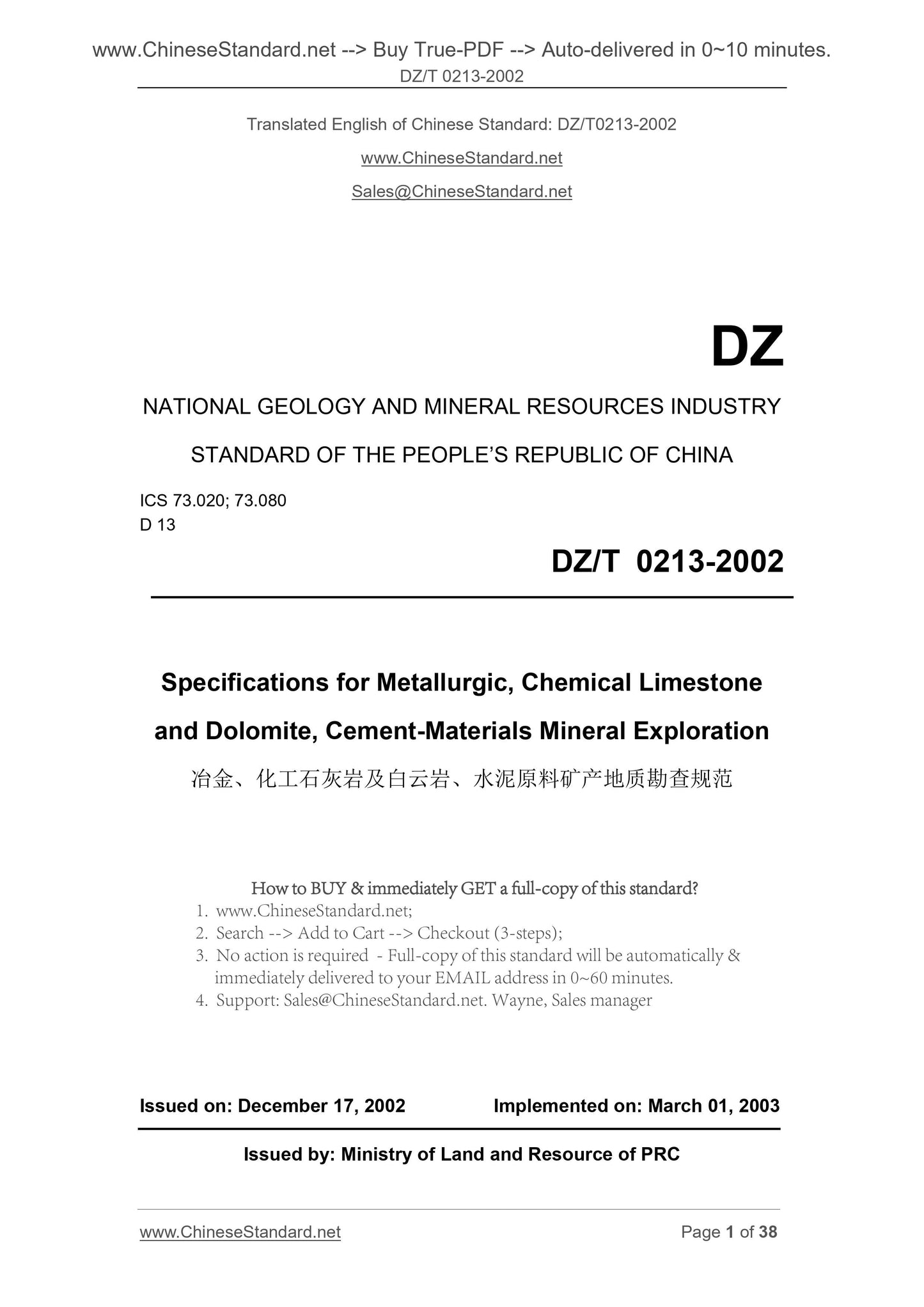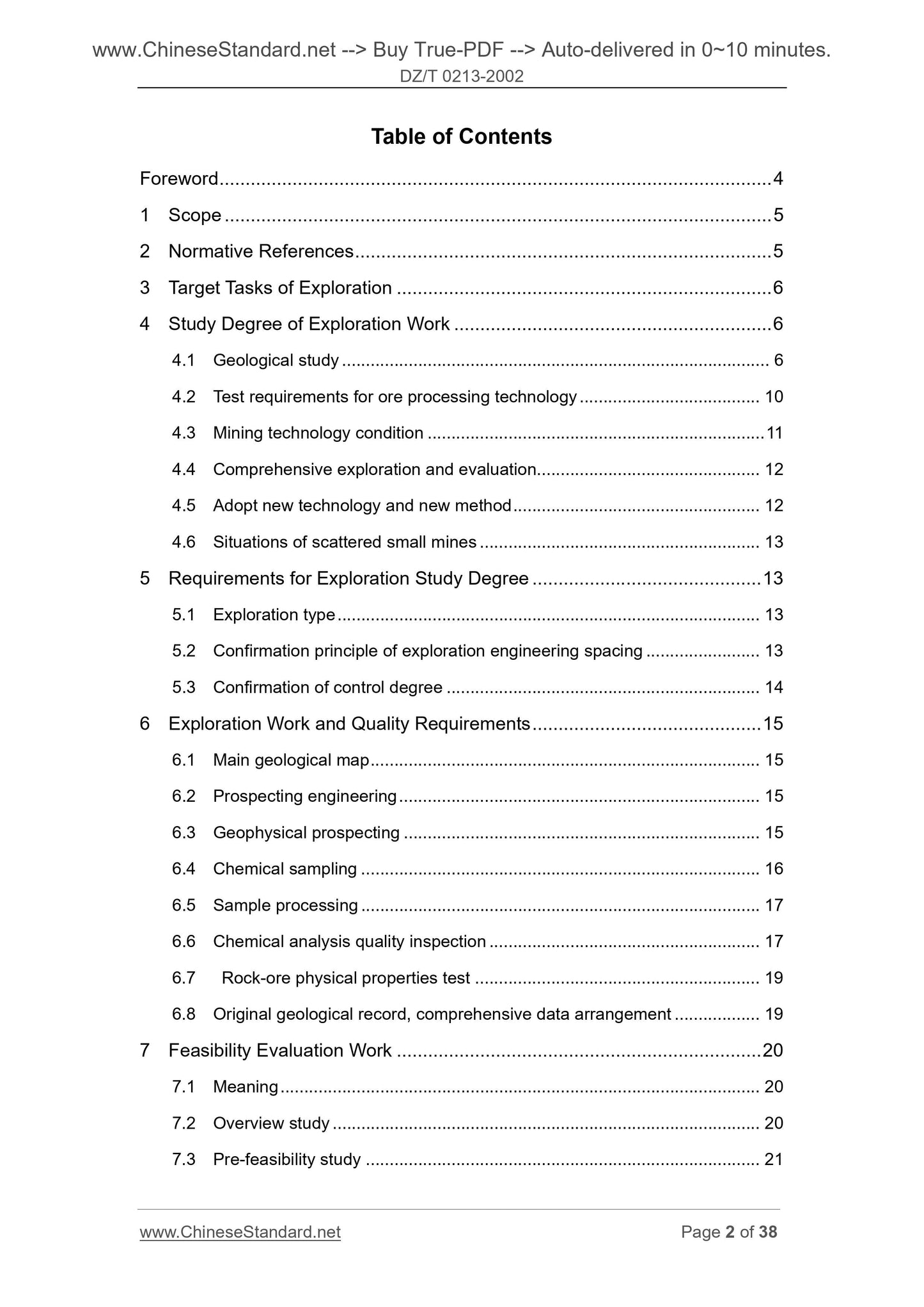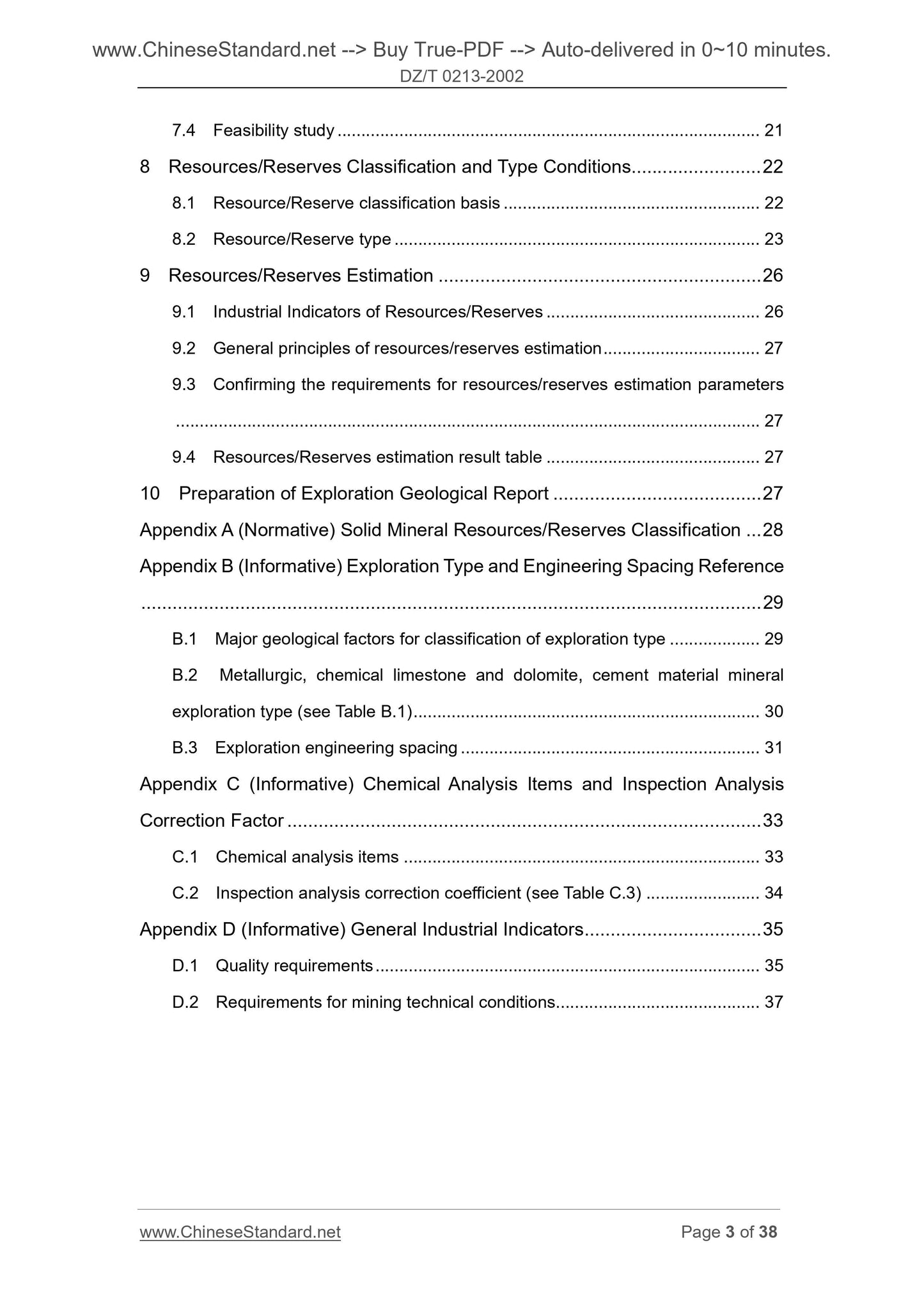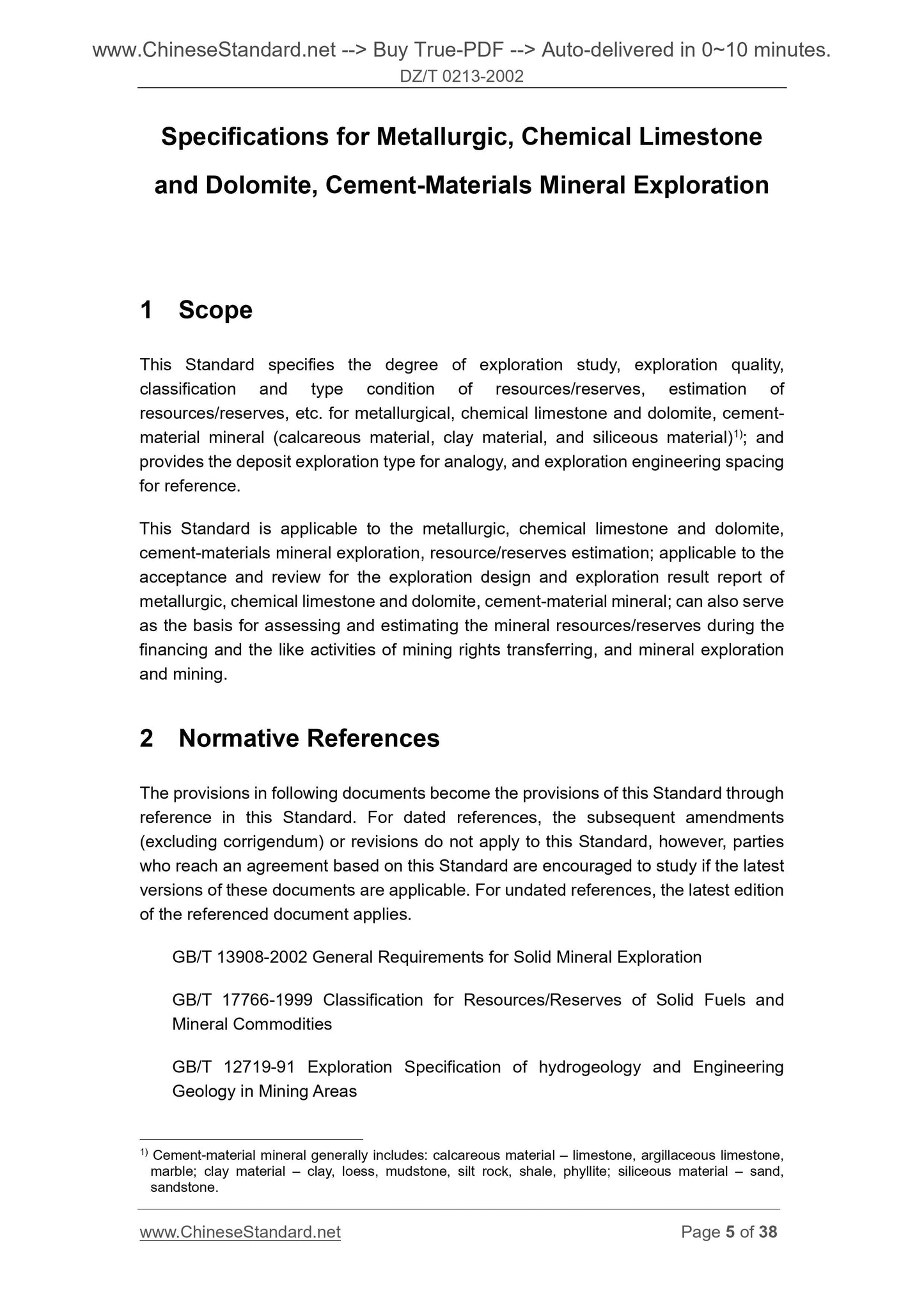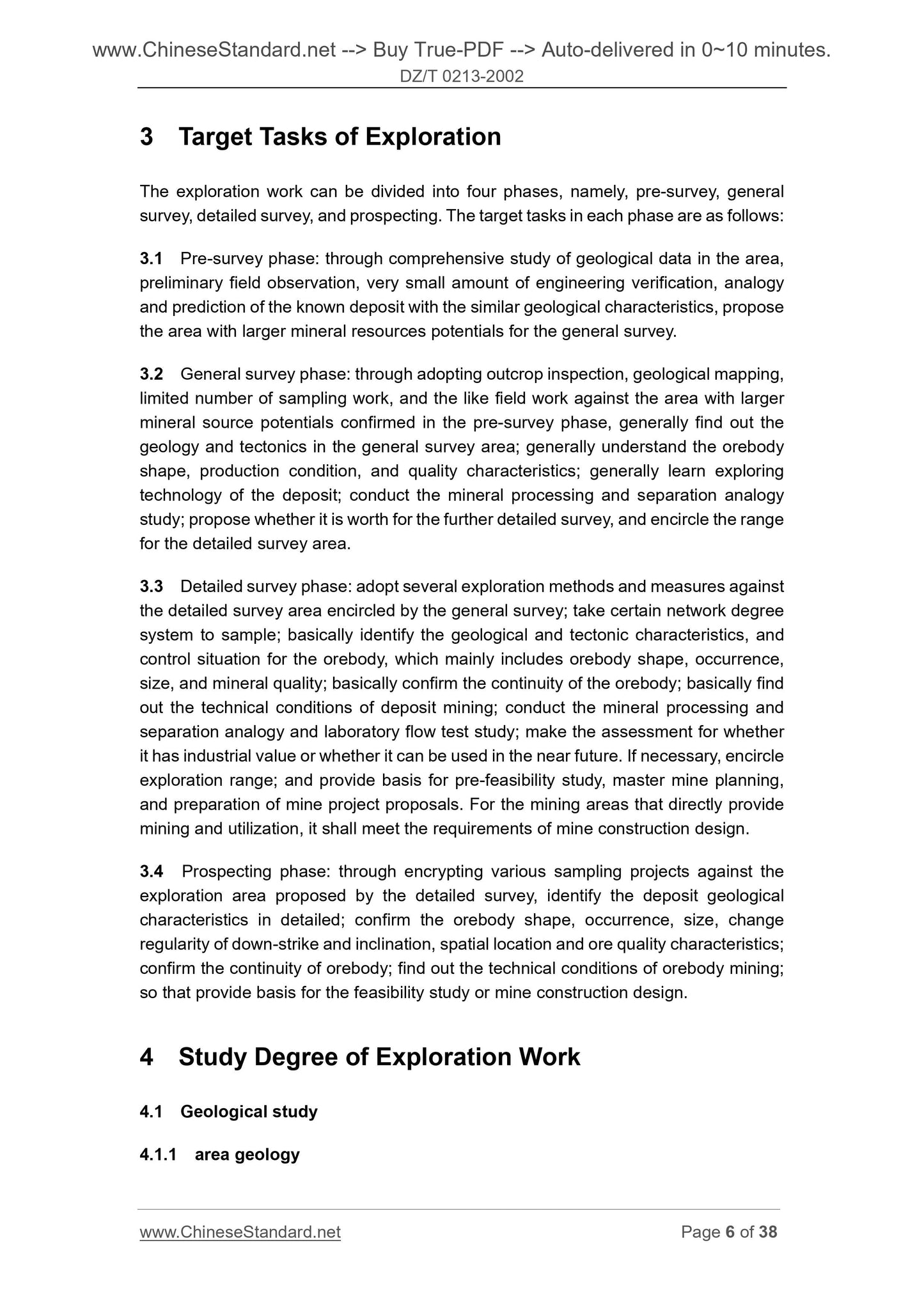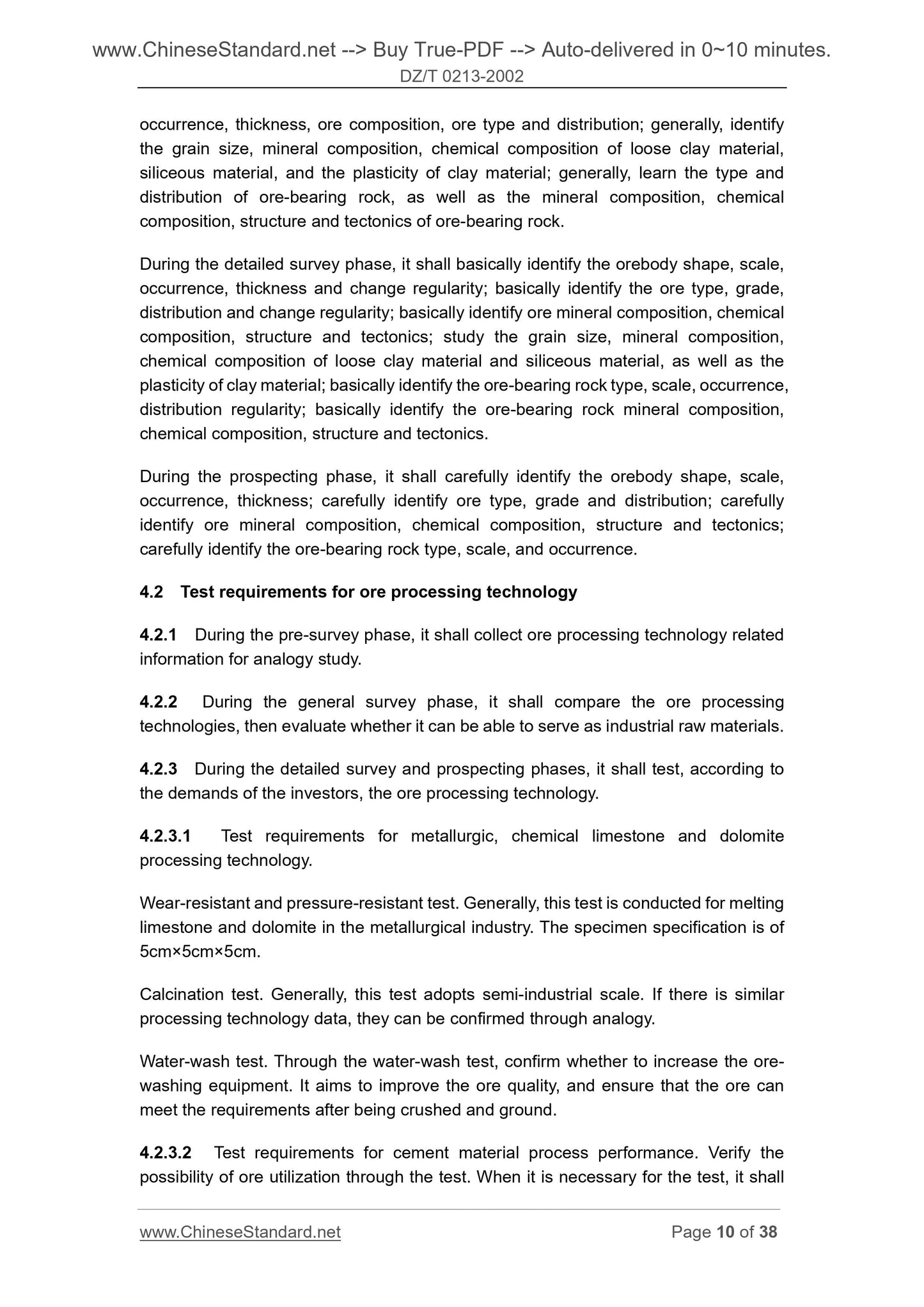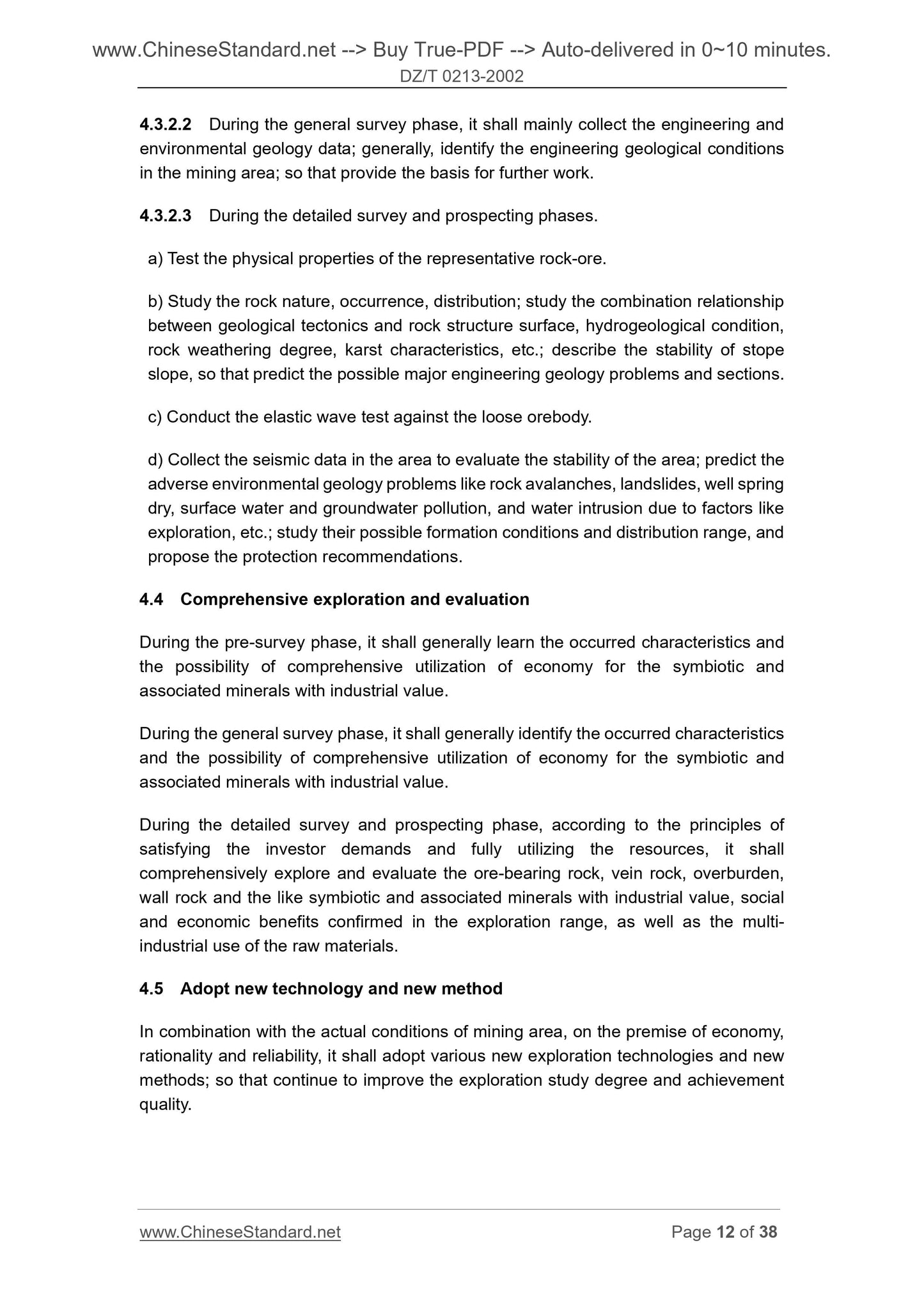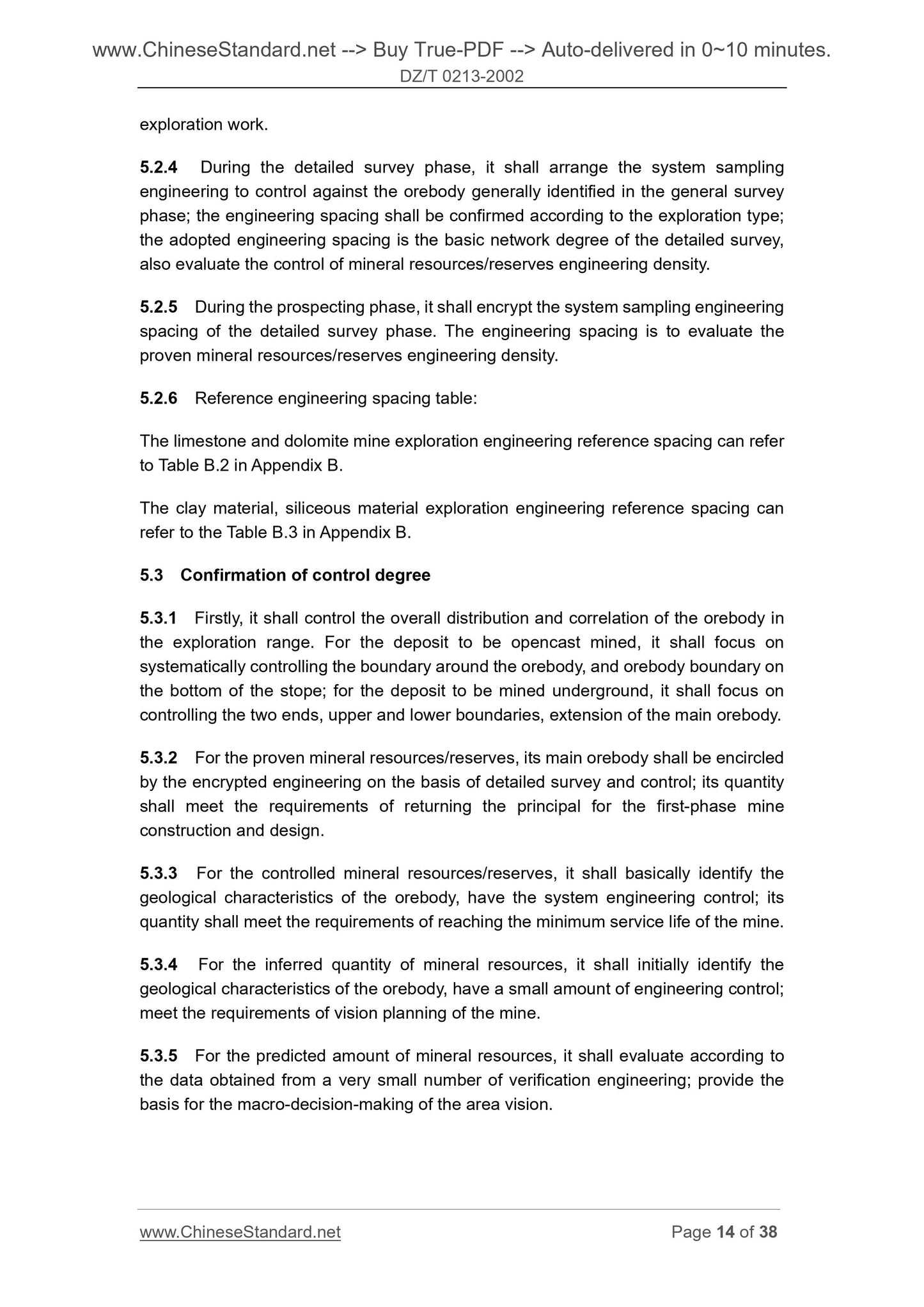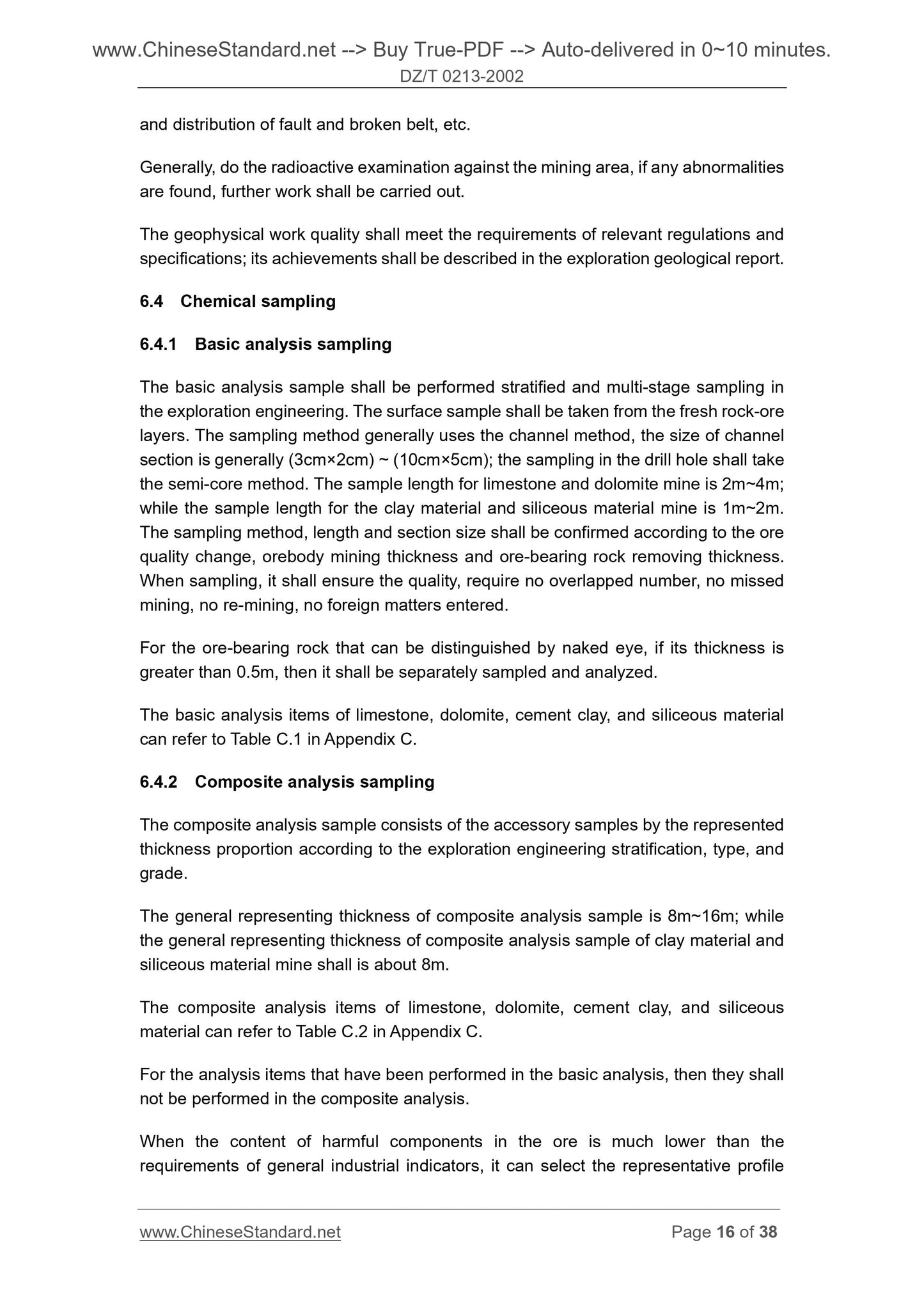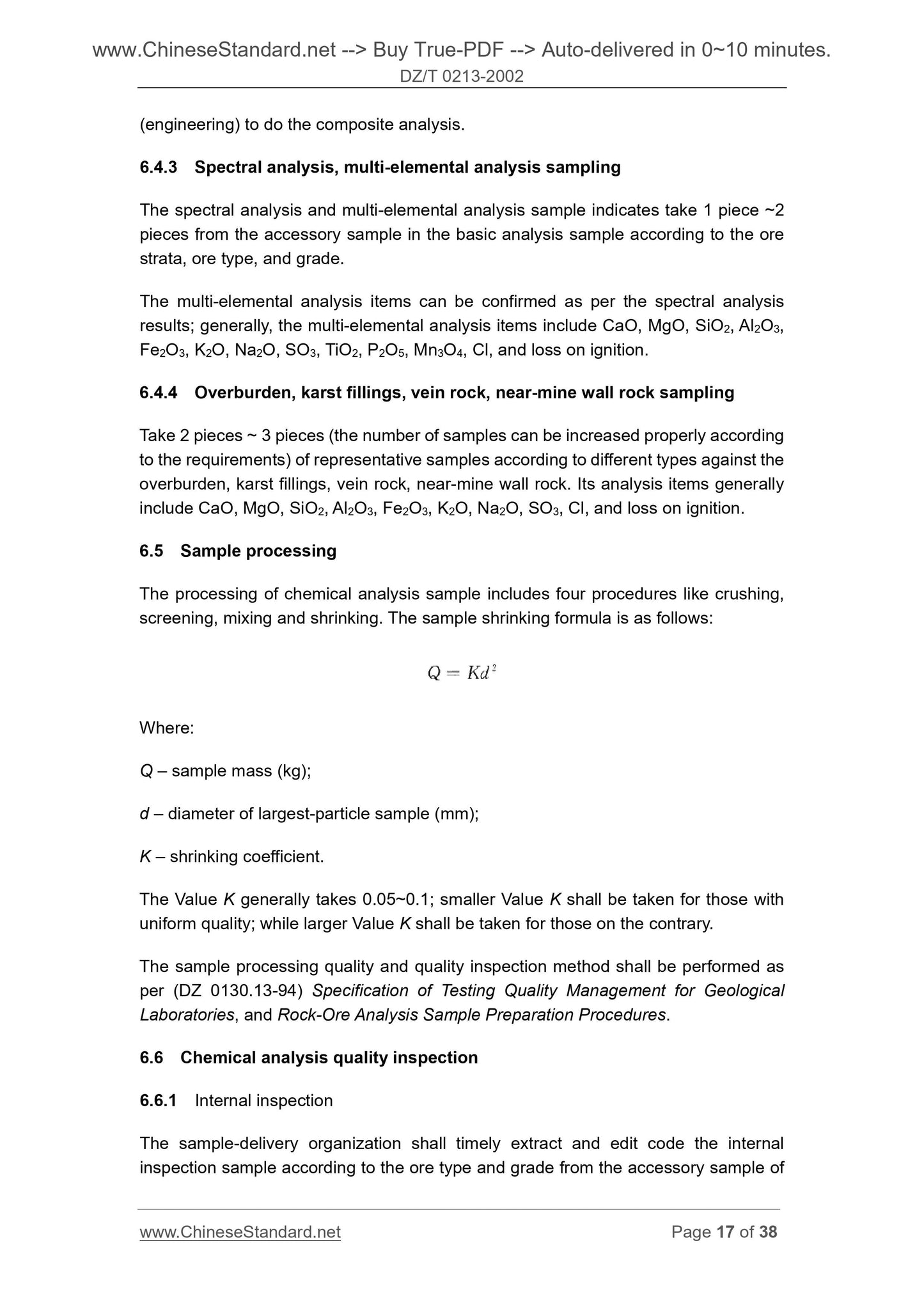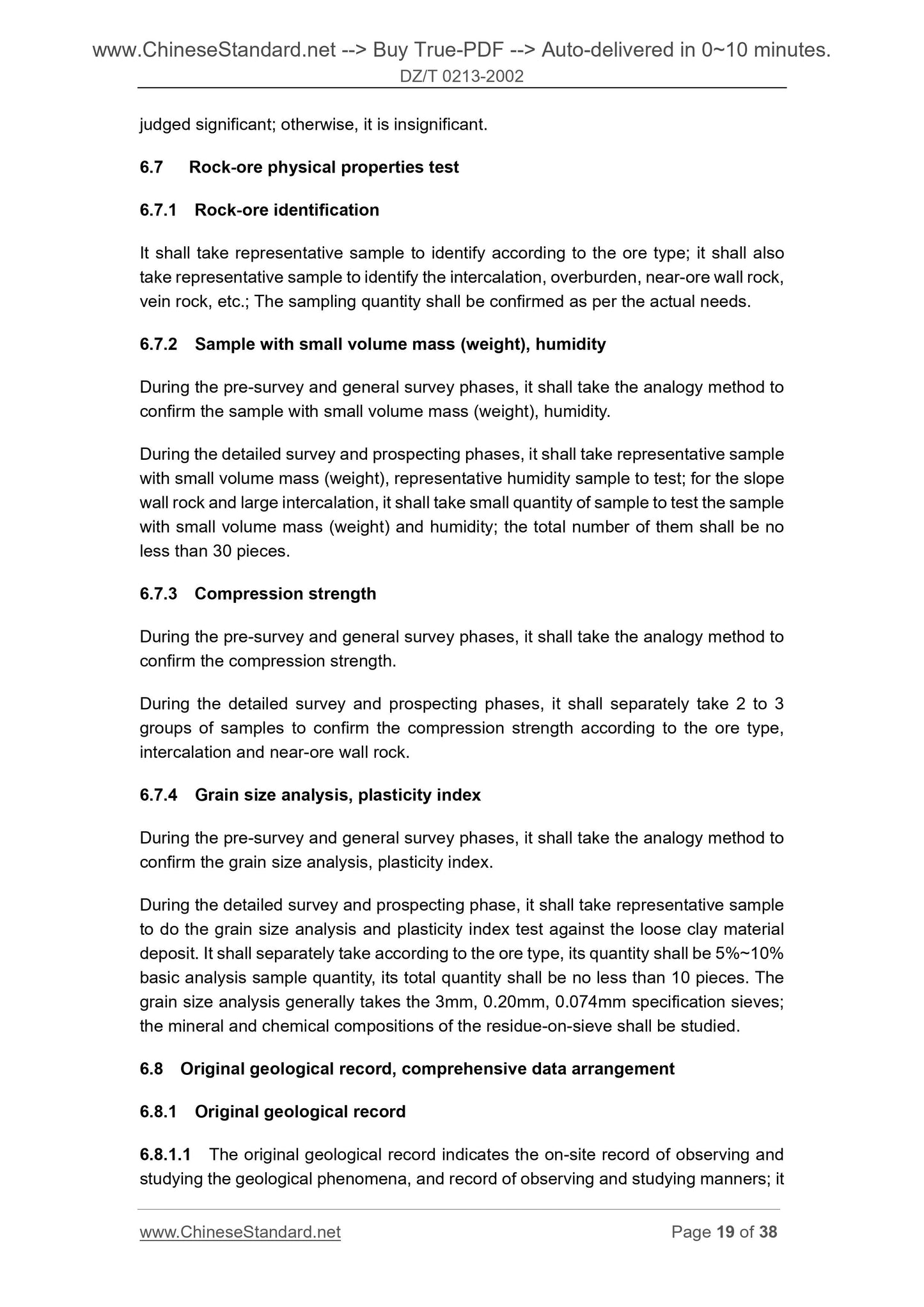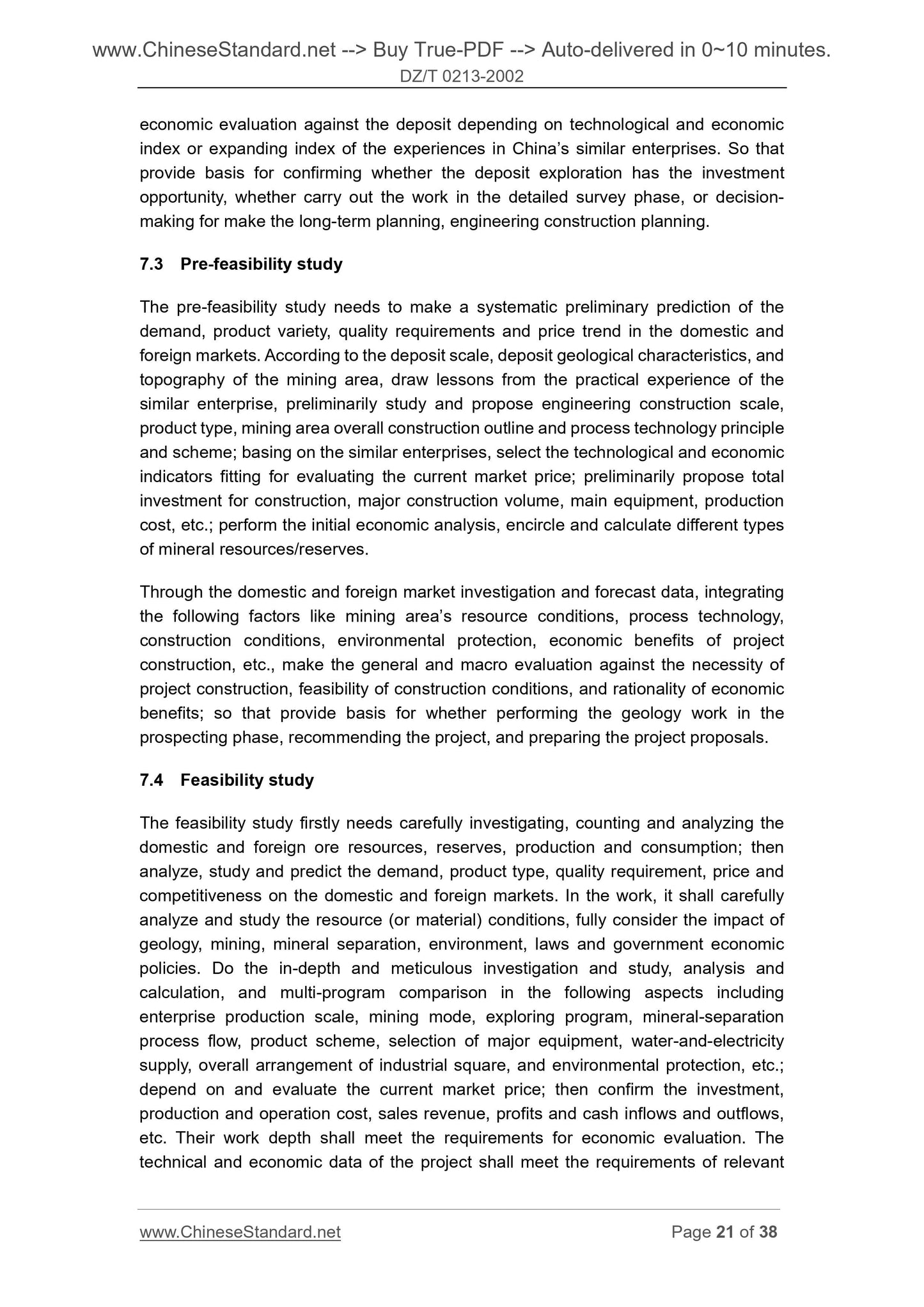1
/
의
12
PayPal, credit cards. Download editable-PDF and invoice in 1 second!
DZ/T 0213-2002 English PDF (DZT0213-2002)
DZ/T 0213-2002 English PDF (DZT0213-2002)
정가
$160.00 USD
정가
할인가
$160.00 USD
단가
/
단위
배송료는 결제 시 계산됩니다.
픽업 사용 가능 여부를 로드할 수 없습니다.
Delivery: 3 seconds. Download true-PDF + Invoice.
Get QUOTATION in 1-minute: Click DZ/T 0213-2002
Historical versions: DZ/T 0213-2002
Preview True-PDF (Reload/Scroll if blank)
DZ/T 0213-2002: Specifications for metallurgic, chemical limestone and dolomite, cement-materials mineral exploration
DZ/T 0213-2002
DZ
NATIONAL GEOLOGY AND MINERAL RESOURCES INDUSTRY
STANDARD OF THE PEOPLE’S REPUBLIC OF CHINA
ICS 73.020; 73.080
D 13
Specifications for Metallurgic, Chemical Limestone
and Dolomite, Cement-Materials Mineral Exploration
ISSUED ON. DECEMBER 17, 2002
IMPLEMENTED ON. MARCH 01, 2003
Issued by. Ministry of Land and Resource of PRC
3. No action is required - Full-copy of this standard will be automatically and
immediately delivered to your EMAIL address in 0~60 minutes.
Table of Contents
Foreword ... 4
1 Scope ... 5
2 Normative References ... 5
3 Target Tasks of Exploration ... 6
4 Study Degree of Exploration Work ... 6
4.1 Geological study ... 6
4.2 Test requirements for ore processing technology ... 10
4.3 Mining technology condition ... 11
4.4 Comprehensive exploration and evaluation... 12
4.5 Adopt new technology and new method ... 12
4.6 Situations of scattered small mines ... 13
5 Requirements for Exploration Study Degree ... 13
5.1 Exploration type ... 13
5.2 Confirmation principle of exploration engineering spacing ... 13
5.3 Confirmation of control degree ... 14
6 Exploration Work and Quality Requirements ... 15
6.1 Main geological map ... 15
6.2 Prospecting engineering ... 15
6.3 Geophysical prospecting ... 15
6.4 Chemical sampling ... 16
6.5 Sample processing ... 17
6.6 Chemical analysis quality inspection ... 17
6.7 Rock-ore physical properties test ... 19
6.8 Original geological record, comprehensive data arrangement ... 19
7 Feasibility Evaluation Work ... 20
7.1 Meaning ... 20
7.2 Overview study ... 20
7.3 Pre-feasibility study ... 21
7.4 Feasibility study ... 21
8 Resources/Reserves Classification and Type Conditions... 22
8.1 Resource/Reserve classification basis ... 22
8.2 Resource/Reserve type ... 23
9 Resources/Reserves Estimation ... 26
9.1 Industrial Indicators of Resources/Reserves ... 26
9.2 General principles of resources/reserves estimation ... 27
9.3 Confirming the requirements for resources/reserves estimation parameters
... 27
9.4 Resources/Reserves estimation result table ... 27
10 Preparation of Exploration Geological Report ... 27
Appendix A (Normative) Solid Mineral Resources/Reserves Classification ... 28
Appendix B (Informative) Exploration Type and Engineering Spacing Reference
... 29
B.1 Major geological factors for classification of exploration type ... 29
B.2 Metallurgic, chemical limestone and dolomite, cement material mineral
exploration type (see Table B.1) ... 30
B.3 Exploration engineering spacing ... 31
Appendix C (Informative) Chemical Analysis Items and Inspection Analysis
Correction Factor ... 33
C.1 Chemical analysis items ... 33
C.2 Inspection analysis correction coefficient (see Table C.3) ... 34
Appendix D (Informative) General Industrial Indicators ... 35
D.1 Quality requirements ... 35
D.2 Requirements for mining technical conditions... 37
Specifications for Metallurgic, Chemical Limestone
and Dolomite, Cement-Materials Mineral Exploration
1 Scope
This Standard specifies the degree of exploration study, exploration quality,
classification and type condition of resources/reserves, estimation of
resources/reserves, etc. for metallurgical, chemical limestone and dolomite, cement-
material mineral (calcareous material, clay material, and siliceous material)1); and
provides the deposit exploration type for analogy, and exploration engineering spacing
for reference.
This Standard is applicable to the metallurgic, chemical limestone and dolomite,
cement-materials mineral exploration, resource/reserves estimation; applicable to the
acceptance and review for the exploration design and exploration result report of
metallurgic, chemical limestone and dolomite, cement-material mineral; can also serve
as the basis for assessing and estimating the mineral resources/reserves during the
financing and the like activities of mining rights transferring, and mineral exploration
and mining.
2 Normative References
The provisions in following documents become the provisions of this Standard through
reference in this Standard. For dated references, the subsequent amendments
(excluding corrigendum) or revisions do not apply to this Standard, however, parties
who reach an agreement based on this Standard are encouraged to study if the latest
versions of these documents are applicable. For undated references, the latest edition
of the referenced document applies.
GB/T 13908-2002 General Requirements for Solid Mineral Exploration
GB/T 17766-1999 Classification for Resources/Reserves of Solid Fuels and
Mineral Commodities
GB/T 12719-91 Exploration Specification of hydrogeology and Engineering
Geology in Mining Areas
1) Cement-material mineral generally includes. calcareous material – limestone, argillaceous limestone,
marble; clay material – clay, loess, mudstone, silt rock, shale, phyllite; siliceous material – sand,
sandstone.
3 Target Tasks of Exploration
The exploration work can be divided into four phases, namely, pre-survey, general
survey, detailed survey, and prospecting. The target tasks in each phase are as follows.
3.1 Pre-survey phase. through comprehensive study of geological data in the area,
preliminary field observation, very small amount of engineering verification, analogy
and prediction of the known deposit with the similar geological characteristics, propose
the area with larger mineral resources potentials for the general survey.
3.2 General survey phase. through adopting outcrop inspection, geological mapping,
limited number of sampling work, and the like field work against the area with larger
mineral source potentials confirmed in the pre-survey phase, generally find out the
geology and tectonics in the general survey area; generally understand the orebody
shape, production condition, and quality characteristics; generally learn exploring
technology of the deposit; conduct the mineral processing and separation analogy
study; propose whether it is worth for the further detailed survey, and encircle the range
for the detailed survey area.
3.3 Detailed survey phase. adopt several exploration methods and measures against
the detailed survey area encircled by the general survey; take certain network degree
system to sample; basically identify the geological and tectonic characteristics, and
control situation for the orebody, which mainly includes orebody shape, occurrence,
size, and mineral quality; basically confirm the continuity of the orebody; basically find
out the technical conditions of deposit mining; conduct the mineral processing and
separation analogy and laboratory flow test study; make the assessment for whether
it has industrial value or whether it can be used in the near future. If necessary, encircle
exploration range; and provide basis for pre-feasibility study, master mine planning,
and preparation of mine project proposals. For the mining areas that directly provide
mining and utilization, it shall meet the requirements of mine construction design.
3.4 Prospecting phase. through encrypting various sampling projects against the
exploration area proposed by the detailed survey, identify the deposit geological
characteristics in detailed; confirm the orebody shape, occurrence, size, change
regularity of down-strike and inclination, spatial location and ore quality characteristics;
confirm the continuity of orebody; find out the technical conditions of ore...
Get QUOTATION in 1-minute: Click DZ/T 0213-2002
Historical versions: DZ/T 0213-2002
Preview True-PDF (Reload/Scroll if blank)
DZ/T 0213-2002: Specifications for metallurgic, chemical limestone and dolomite, cement-materials mineral exploration
DZ/T 0213-2002
DZ
NATIONAL GEOLOGY AND MINERAL RESOURCES INDUSTRY
STANDARD OF THE PEOPLE’S REPUBLIC OF CHINA
ICS 73.020; 73.080
D 13
Specifications for Metallurgic, Chemical Limestone
and Dolomite, Cement-Materials Mineral Exploration
ISSUED ON. DECEMBER 17, 2002
IMPLEMENTED ON. MARCH 01, 2003
Issued by. Ministry of Land and Resource of PRC
3. No action is required - Full-copy of this standard will be automatically and
immediately delivered to your EMAIL address in 0~60 minutes.
Table of Contents
Foreword ... 4
1 Scope ... 5
2 Normative References ... 5
3 Target Tasks of Exploration ... 6
4 Study Degree of Exploration Work ... 6
4.1 Geological study ... 6
4.2 Test requirements for ore processing technology ... 10
4.3 Mining technology condition ... 11
4.4 Comprehensive exploration and evaluation... 12
4.5 Adopt new technology and new method ... 12
4.6 Situations of scattered small mines ... 13
5 Requirements for Exploration Study Degree ... 13
5.1 Exploration type ... 13
5.2 Confirmation principle of exploration engineering spacing ... 13
5.3 Confirmation of control degree ... 14
6 Exploration Work and Quality Requirements ... 15
6.1 Main geological map ... 15
6.2 Prospecting engineering ... 15
6.3 Geophysical prospecting ... 15
6.4 Chemical sampling ... 16
6.5 Sample processing ... 17
6.6 Chemical analysis quality inspection ... 17
6.7 Rock-ore physical properties test ... 19
6.8 Original geological record, comprehensive data arrangement ... 19
7 Feasibility Evaluation Work ... 20
7.1 Meaning ... 20
7.2 Overview study ... 20
7.3 Pre-feasibility study ... 21
7.4 Feasibility study ... 21
8 Resources/Reserves Classification and Type Conditions... 22
8.1 Resource/Reserve classification basis ... 22
8.2 Resource/Reserve type ... 23
9 Resources/Reserves Estimation ... 26
9.1 Industrial Indicators of Resources/Reserves ... 26
9.2 General principles of resources/reserves estimation ... 27
9.3 Confirming the requirements for resources/reserves estimation parameters
... 27
9.4 Resources/Reserves estimation result table ... 27
10 Preparation of Exploration Geological Report ... 27
Appendix A (Normative) Solid Mineral Resources/Reserves Classification ... 28
Appendix B (Informative) Exploration Type and Engineering Spacing Reference
... 29
B.1 Major geological factors for classification of exploration type ... 29
B.2 Metallurgic, chemical limestone and dolomite, cement material mineral
exploration type (see Table B.1) ... 30
B.3 Exploration engineering spacing ... 31
Appendix C (Informative) Chemical Analysis Items and Inspection Analysis
Correction Factor ... 33
C.1 Chemical analysis items ... 33
C.2 Inspection analysis correction coefficient (see Table C.3) ... 34
Appendix D (Informative) General Industrial Indicators ... 35
D.1 Quality requirements ... 35
D.2 Requirements for mining technical conditions... 37
Specifications for Metallurgic, Chemical Limestone
and Dolomite, Cement-Materials Mineral Exploration
1 Scope
This Standard specifies the degree of exploration study, exploration quality,
classification and type condition of resources/reserves, estimation of
resources/reserves, etc. for metallurgical, chemical limestone and dolomite, cement-
material mineral (calcareous material, clay material, and siliceous material)1); and
provides the deposit exploration type for analogy, and exploration engineering spacing
for reference.
This Standard is applicable to the metallurgic, chemical limestone and dolomite,
cement-materials mineral exploration, resource/reserves estimation; applicable to the
acceptance and review for the exploration design and exploration result report of
metallurgic, chemical limestone and dolomite, cement-material mineral; can also serve
as the basis for assessing and estimating the mineral resources/reserves during the
financing and the like activities of mining rights transferring, and mineral exploration
and mining.
2 Normative References
The provisions in following documents become the provisions of this Standard through
reference in this Standard. For dated references, the subsequent amendments
(excluding corrigendum) or revisions do not apply to this Standard, however, parties
who reach an agreement based on this Standard are encouraged to study if the latest
versions of these documents are applicable. For undated references, the latest edition
of the referenced document applies.
GB/T 13908-2002 General Requirements for Solid Mineral Exploration
GB/T 17766-1999 Classification for Resources/Reserves of Solid Fuels and
Mineral Commodities
GB/T 12719-91 Exploration Specification of hydrogeology and Engineering
Geology in Mining Areas
1) Cement-material mineral generally includes. calcareous material – limestone, argillaceous limestone,
marble; clay material – clay, loess, mudstone, silt rock, shale, phyllite; siliceous material – sand,
sandstone.
3 Target Tasks of Exploration
The exploration work can be divided into four phases, namely, pre-survey, general
survey, detailed survey, and prospecting. The target tasks in each phase are as follows.
3.1 Pre-survey phase. through comprehensive study of geological data in the area,
preliminary field observation, very small amount of engineering verification, analogy
and prediction of the known deposit with the similar geological characteristics, propose
the area with larger mineral resources potentials for the general survey.
3.2 General survey phase. through adopting outcrop inspection, geological mapping,
limited number of sampling work, and the like field work against the area with larger
mineral source potentials confirmed in the pre-survey phase, generally find out the
geology and tectonics in the general survey area; generally understand the orebody
shape, production condition, and quality characteristics; generally learn exploring
technology of the deposit; conduct the mineral processing and separation analogy
study; propose whether it is worth for the further detailed survey, and encircle the range
for the detailed survey area.
3.3 Detailed survey phase. adopt several exploration methods and measures against
the detailed survey area encircled by the general survey; take certain network degree
system to sample; basically identify the geological and tectonic characteristics, and
control situation for the orebody, which mainly includes orebody shape, occurrence,
size, and mineral quality; basically confirm the continuity of the orebody; basically find
out the technical conditions of deposit mining; conduct the mineral processing and
separation analogy and laboratory flow test study; make the assessment for whether
it has industrial value or whether it can be used in the near future. If necessary, encircle
exploration range; and provide basis for pre-feasibility study, master mine planning,
and preparation of mine project proposals. For the mining areas that directly provide
mining and utilization, it shall meet the requirements of mine construction design.
3.4 Prospecting phase. through encrypting various sampling projects against the
exploration area proposed by the detailed survey, identify the deposit geological
characteristics in detailed; confirm the orebody shape, occurrence, size, change
regularity of down-strike and inclination, spatial location and ore quality characteristics;
confirm the continuity of orebody; find out the technical conditions of ore...
Share
